Introduction:
Recently, SBTi has updated the list of companies that have joined the initiative on its official website. 121 companies[1] have been labeled "COMMITMENT REMOVED". 100 foreign companies including Amazon, Schneider Electric, and Yahoo Japan, as well as 21 Chinese companies (including companies in Hong Kong, China, and Taiwan, China) including Trina Solar, TCL Mobile Communications, ZTO Express, and Qinhuai Data, failed to meet the deadline within 24 months. Verified the commitments submitted and was removed from SBTi. As a sponsor of SBTi, Amazon cannot escape disaster, which shows SBTi’s determination to fight against “greenwashing”.
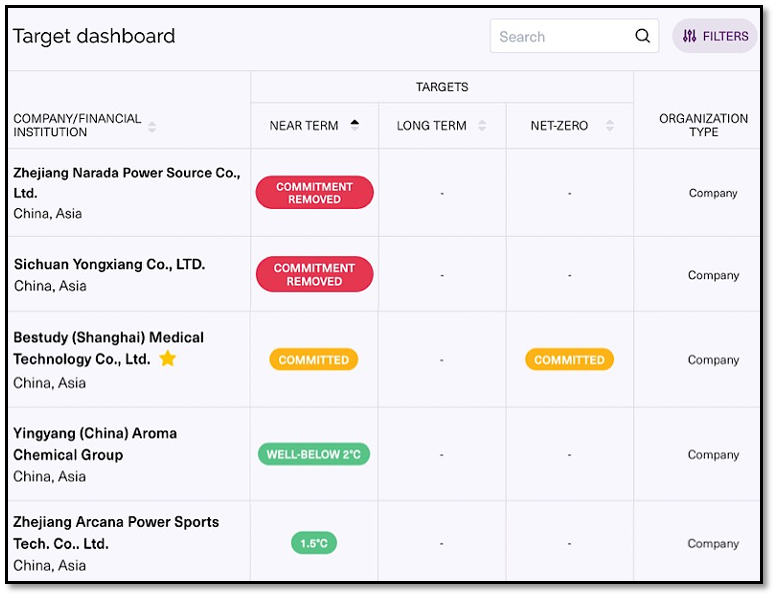
SBTi official website public information (https://sciencebasedtargets.org/companies-taking-action)
Remark:
1. "COMMITMENT REMOVED" means that the enterprise/organization has not verified the target within the deadline and is marked as "Commitment Removed" by SBTi;
2. "COMMITTED" means that the enterprise/organization has made a commitment, has not yet verified the goal, and is still within the 24-month commitment period;
3. "2℃/WELL-BELOW 2℃/1.5℃" means that the enterprise/organization has set short-term/long-term goals and has been verified by SBTi. 2℃/1.5℃ means that the goals set by enterprises are consistent with the goal of limiting global warming to the 2℃/1.5℃ range.
4.⭐️Indicates that the company is a member of the Business Ambition for 1.5 campaign, which is led by SBTi and aims to control temperature rise to within 1.5°C above pre-industrial revolution levels to prevent the most serious consequences of climate change. , to avoid irreversible damage to society, economy and nature.

1.About SBTi
What is SBTi?
SBTi (Science Based Targets initiative) was founded in 2015 by the environmental information disclosure organization CDP, the United Nations Global Compact UNGC, the World Resources Institute WRI and the World Wildlife Fund WWF. It aims to advocate enterprises to establish "science-based targets". (emission reduction targets in line with the Paris Agreement)" and provide third-party verification for the targets set by companies

Sponsoring organization of SBTi
In recent years, the number of companies joining SBTi has increased significantly (see the figure below). SBTi has almost monopolized the business of certifying climate goals for major companies. Apple, Amazon, Alibaba, Yum, JA Solar and other 6,040 companies/institutions with extensive global influence (including 237 companies from mainland China, 1 company from Macau, China, 60 companies from Hong Kong, China, and 118 companies from Taiwan, China ) have submitted their commitments to SBTi, and currently 3,383 companies or organizations have passed target verification.
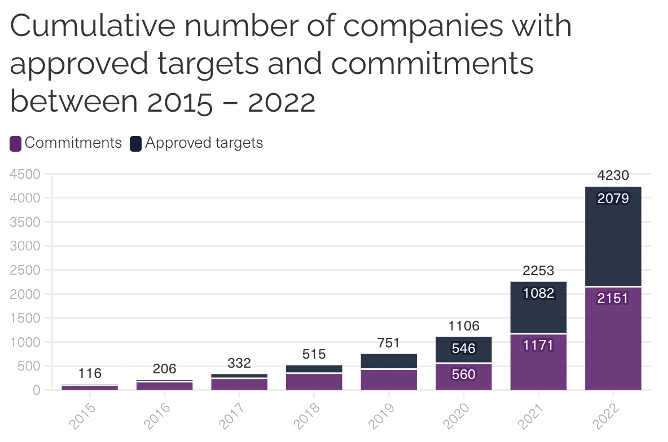
Number of companies/organizations joining SBTi from 2015 to 2022
Why are companies rushing to join SBTi?
As a guiding framework for corporate emission reduction, SBTi enjoys a high reputation in the field of climate emission reduction. In November 2022, the U.S. federal government, the world's largest purchaser, also required federal contractors to set science-based emission reduction targets in line with SBTi to reduce emissions throughout the supply chain and thereby reduce climate-related risks. For enterprises/financial institutions, "joining SBTi" or "goals being verified by SBTi" is a "green honor". It can not only show the public that their climate goals are consistent with the Paris Agreement, but more importantly, this goal It is scientific and verifiable to gain public trust and comply with the low-carbon requirements of the downstream supply chain. Companies can also use it as ESG disclosure and company promotional materials, as shown in the figure below.
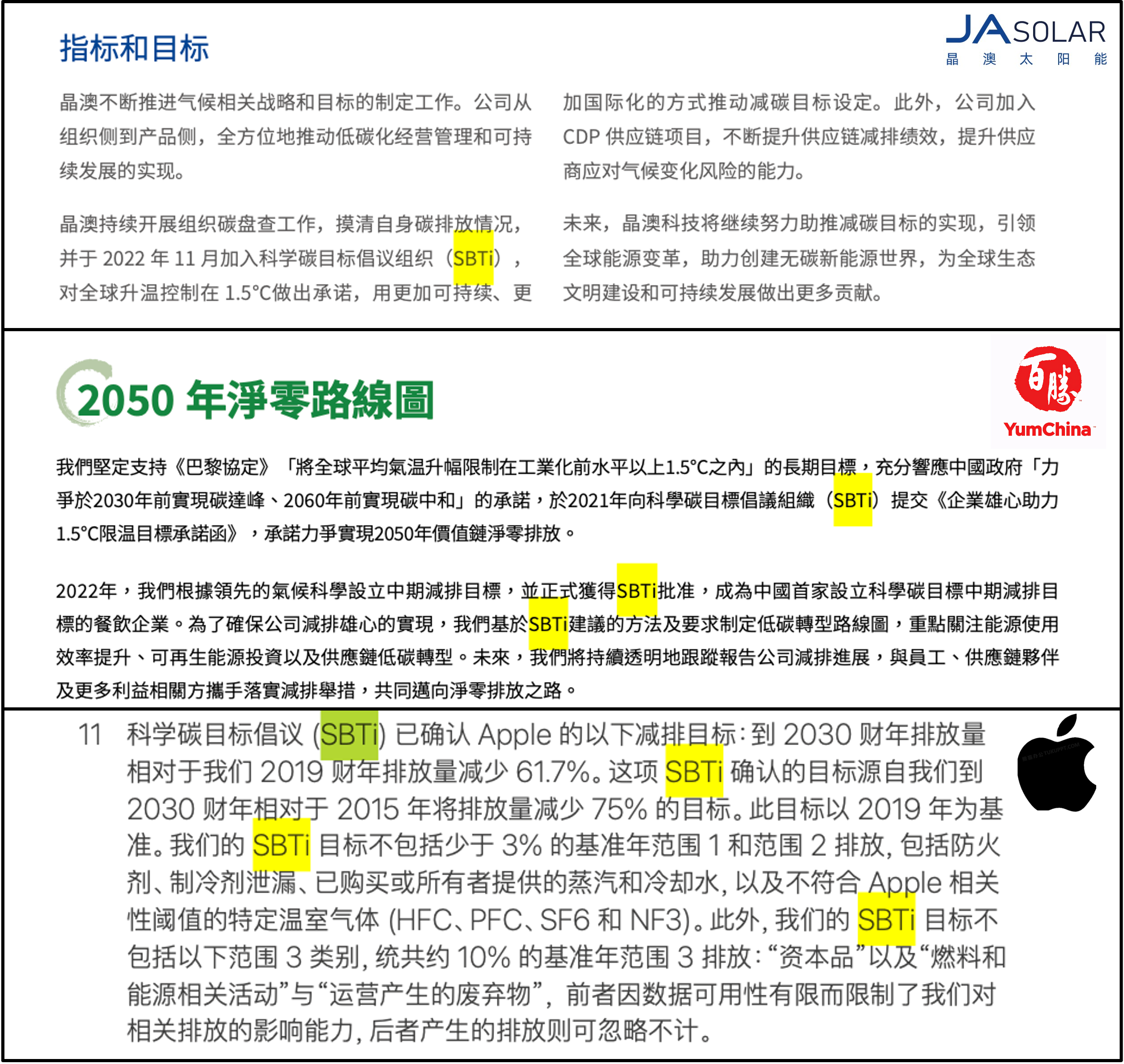
2.The process and consequences of companies joining SBTi and being removed from SBTi.
How can companies join SBTi?
An enterprise has completed the SBTi certification process, which is usually divided into five stages: 1) The enterprise submits a letter of commitment; 2) Sets the near-term (near-term, required), long-term (long-term, recommended), Net-zero (recommended) emission reduction targets; 3) Submit emission reduction targets and verify them by SBTi; 4) After verification is completed, publish them through the SBTi official website and communicate with corporate stakeholders; 5) Disclose carbon emissions and The progress of carbon targets is shown in the figure below. The companies that were delisted this time were due to their failure to effectively complete the "submit goals and verify them."

The process of joining SBTi
The process and consequences of companies being delisted by SBTi can be understood in one picture. The time and events of SBTi delisting non-compliant companies are reviewed on the official website.
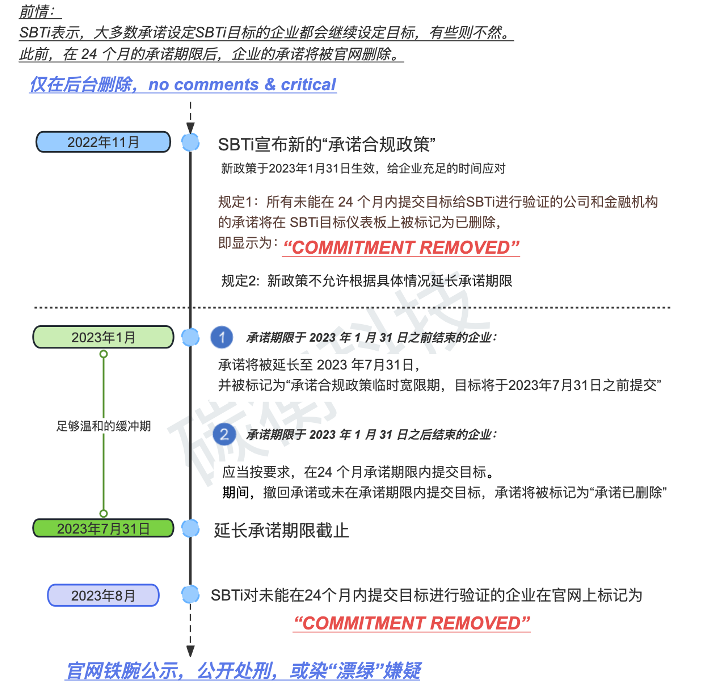
Time chart for SBTi’s release and implementation of new commitment compliance policies
It is not difficult to see that SBTi has always adhered to the principle of "delete its commitments if the company does not submit its goals for verification within 24 months." The difference before and after the release of the new commitment compliance policy is: before the new policy, the official website would only quietly appear in the background Deletes the commitments of non-compliant companies without making any judgment; after the implementation of the new policy, the official website will not only not delete the names of non-compliant companies (including companies that withdraw their commitments), but will also mark the commitments of non-compliant companies with "COMMITMENT REMOVED" Labeling is equivalent to a public execution of a company, declaring it to be dishonest.
Compared with the previous silent deletion, what are the consequences of the current delisting label for enterprises? When the "green coat" that companies put on by joining SBTi in the early stage is stripped away, "greenwashing" may also be imprinted on the company - after all, if the short-term emission reduction targets for 5-10 years submitted are not included, It is impossible for the public to believe that companies can implement ambitious emission reduction plans lasting 30 years or even longer, so the early promises made by companies are false promises. Once a company is suspected of "greenwashing", its image and credibility will be greatly compromised.
3.Taking action against its sponsors, SBTi is also under the supervision of "greenwashing"
Even as a sponsor of SBTi, Amazon cannot escape accountability
Amazon was once one of the three core sponsors of SBTi. The Earth Foundation, owned by Amazon boss Bezos, is still a core sponsor of SBTi. Amazon can be said to be a veritable major sponsor of SBTi. But even so, Amazon was still labeled, and because of this, Amazon was the first to bear the brunt and attracted much attention.
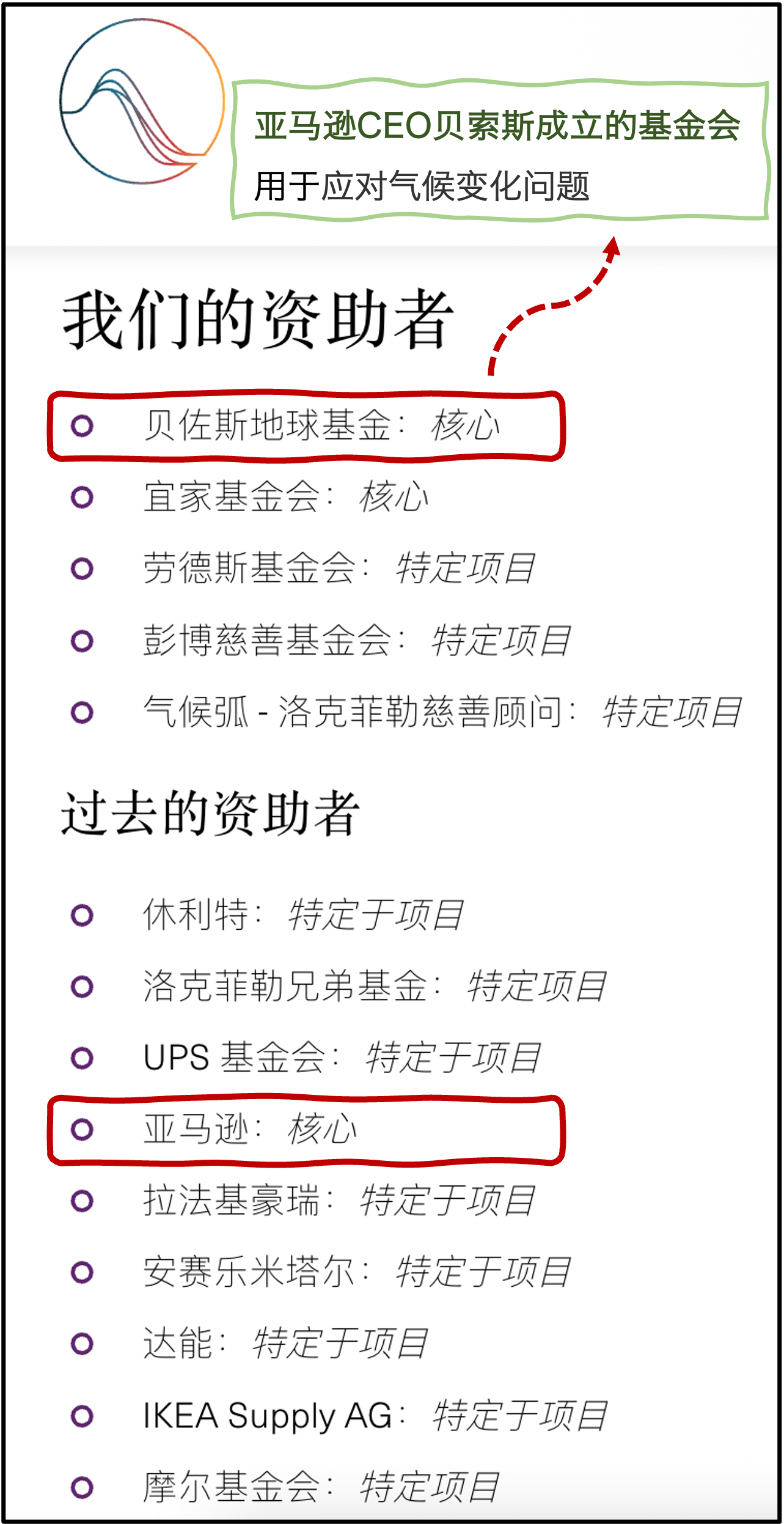
As a sponsor of SBTi (information from the official website)
Amazon submitted short-term (5-10 years) climate goals to SBTi as early as 2020, but has been unable to provide further short-term goals or roadmaps. After being delisted, Amazon immediately issued an announcement stating that it was not unwilling to submit, but the goal was "difficult to submit in a meaningful and accurate way." Objectively speaking, Amazon is not inactive in sustainable transformation. Since 2020, Amazon has been the largest buyer of renewable energy, with 20GW of renewable energy projects (Bloomberg data). But it’s hard to get back. Amazon’s main business cloud services and logistics are both highly carbon emission intensive. Although the “Amazon 2022 Sustainability Report” indicates that its total carbon footprint decreased by 0.4% in 2022, this is compared to its “ It is far from the goal of "achieving net zero carbon emissions by 2040", and Amazon's path to low carbon is not easy.
SBTi takes action against its sponsors and opposes the general trend of "greenwashing".
If it wants to wear its crown, it must bear its weight. Even with the endorsement of credible NGOs such as the United Nations Compact Organization UNGC and World Resources Institute WRI, SBTi is still subject to the supervision of "greenwashing". In addition, as a key tool for investment information in the financial market, the performance of SBTi has also attracted capital attention.
“Transparency and accountability are at the heart of our Science-Based Targets Initiative (SBTi) work,” SBTi emphasized in launching its new commitment compliance policy.
While enjoying a high degree of global recognition and trust, SBTi is also being questioned by all parties.
For example, the NewClimate Institute once stated that the climate plans of some companies approved by SBTi are controversial. To strike with iron, you need to be hard-working. SBTi ensures it by continuously polishing its own methodologies and standards (currently version 5.0 of the standard has been released), and improving transparency and accountability (implementing the "Conflict of Interest Policy" and "Commitment Compliance Policy", etc.) impartiality. Therefore, even though Amazon is a major financier, SBTi still attacks it mercilessly, which shows its determination to fight against “greenwashing”.
4.How can companies avoid the risk of “greenwashing”?
Recognize the importance of carbon emission management. As the public becomes more and more alert to "greenwashing" behavior, under the dual pressure of policies and public opinion, certification agencies and enterprises need to come up with more transparent, practical, specific, More responsible actions should be subject to supervision from all parties. For certification bodies, companies should be encouraged to develop meaningful climate plans, rather than endorsing “PR literature” that “greenwashes” companies. For enterprises, making emission reduction commitments but not formulating specific goals and plans is "greenwashing"; formulating goals and plans but not implementing them is "greenwashing"; when implementing, they avoid the important and ignore the light (such as intentionally ignoring key emission sources) , Data falsification is also "greenwashing". In short, saying something but not doing it, not doing it thoroughly, not doing it well enough, concealing and exaggerating are all "greenwashing". Therefore, enterprises should increase their awareness and be good at using carbon reduction tools to avoid falling into the misunderstanding of "greenwashing".
With the improvement and introduction of various standards and regulations, the space for "greenwashing" will become smaller and smaller. The consequences of "greenwashing" will only be self-defeating. Not only will it lose credibility and revenue, but it may also be fined and even disrupted. the entire capital market. Once green financial funds are used by "greenwashing" companies, some companies that really need funds to carry out green transformation will face greater difficulties, which will also greatly violate the original intention of "capital for good". Therefore, learning to avoid the risk of “greenwashing” is a required course for every enterprise. Carrying out scientific carbon emission management is the only way for enterprises to avoid "greenwashing".
So how do companies carry out scientific carbon emission management?
(1) Find out the carbon family background. Collect carbon emission-related information, use a professional carbon accounting platform to quantify the company's carbon emissions, and form a carbon emission report that meets relevant domestic and foreign requirements to facilitate supervision and inspection by all parties. A comprehensive understanding of one's own carbon emissions and emission levels in the industry can provide solid data support for subsequent energy conservation and carbon reduction planning.
(2) Identify key points for carbon reduction. By analyzing the carbon emissions of enterprises, that is, the carbon emission structure, we can identify the key points of carbon emissions and the parts with room for carbon reduction, formulate a scientific and feasible carbon reduction roadmap, and predict the effects of various emission reduction paths/schemes through models. , to avoid “greenwashing” carbon reduction.
(3) Reduce carbon emissions. Reduce carbon emissions by using recycled materials, adopting low-carbon process technology, using green energy, etc., and using digital tools to track the progress of emission reductions in real time, and conduct vertical and horizontal comparisons with historical data and the advanced levels of peers to facilitate enterprises to dynamically adjust emission reductions. plan to achieve emission reduction targets ahead of schedule. At the same time, carbon footprint certification for low-carbon products can provide good social repercussions for corporate carbon reduction.
(4) Offset carbon emissions. In fact, it is impossible for most enterprises to completely achieve "zero" emissions during their production and operations. The part that cannot be reduced can be purchased with carbon credits to offset the remaining carbon emissions, and then connected to a third-party authoritative agency for verification and certification to achieve carbon neutrality. Specific cases You can refer to "Tiqiao Textile Obtains Carbon Neutral Certification for Air Layer Fabric Products" (it should be noted that own emission reduction is always the first priority). In addition, enterprises use digital green supply chain systems to achieve carbon neutrality in the supply chain, which is also an indispensable link in achieving carbon neutrality.
Note: [1] The 121 companies include 5 financial institutions. For the convenience of reading, the article refers to companies and financial institutions collectively as "enterprises".
reference:
https://sciencebasedtargets.org/blog/commitment-compliance-policy-what-you-need-to-know
https://www.ebrun.com/20230831/527493.shtml
https://mp.weixin.qq.com/s/OMoxLpfD7VP1oK_qAp0jMA
https://www.jiemian.com/article/10030796.html
https://www.newclimate.org/news/press-release-corporate-climate-responsibility-monitor-2023